You can create a new credential, configure its properties, and assign it to a cardholder or visitor, using the Credential management task.
What you should know
To create a credential:
-
In the Credential management task, click Create
new credential (
 ).
).
-
Select one of the following options:
- Automatic entry:
 Present the card at a reader.
Present the card at a reader. - Manual entry:
 Manually enter the card data. Use this method when you do not have a card reader near you.
Manually enter the card data. Use this method when you do not have a card reader near you. - PIN:
 Create a PIN credential.
Create a PIN credential. - License plate:
 Enter a cardholder's license plate number. Use this method if a Sharp camera is being used to trigger a vehicle access barrier. In this case, the cardholder's vehicle license plate can be used as a credential.
Enter a cardholder's license plate number. Use this method if a Sharp camera is being used to trigger a vehicle access barrier. In this case, the cardholder's vehicle license plate can be used as a credential.
-
If you select Automatic entry, you must then select a reader
(USB reader or a door) and present the card at the reader.
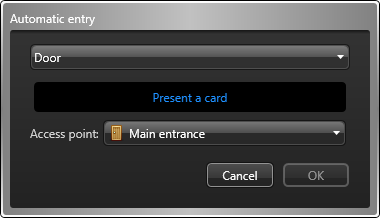
If you have a smart card encoding reader set up, set the option Encode before enrollment to OFF to read a pre-encoded card.
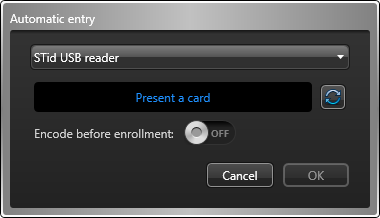
When the reader LED turns green (ready to read), place the smart card on the reader. The reader LED turns yellow and then green with a short beep before turning off.
If you want to generate and encode on your card a random 128-bit MIFARE DESFire credential before enrolling it, set the option Encode before enrollment to ON.NOTE: Your Security Center license must support smart card encoding.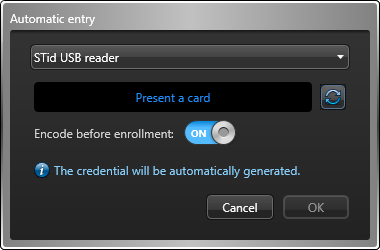
When the reader LED turns red (ready to encode), place the smart card on the reader for approximately 2 seconds. The reader LED turns yellow and then green with a short beep before turning off. If you hear a long beep and the LED stays red, try again.
-
If you select Manual entry, you must then select a card
format, enter the required data fields, and click OK.
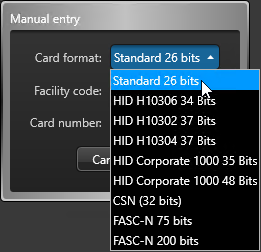 CAUTION: Enter your card data carefully, because the system cannot validate whether the data you entered correspond to a physical card or not.
CAUTION: Enter your card data carefully, because the system cannot validate whether the data you entered correspond to a physical card or not. -
If you select PIN, you must then do the following:
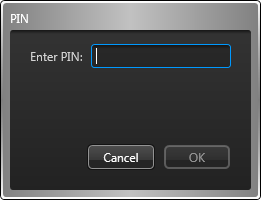
-
Enter the PIN as a numerical value.
NOTE: Be careful not to exceed the number of digits accepted by your readers. A typical PIN length is five digits. But certain models accept up to 15 digits.
- Click OK.
-
Enter the PIN as a numerical value.
-
If you select License plate, you must then do the
following:
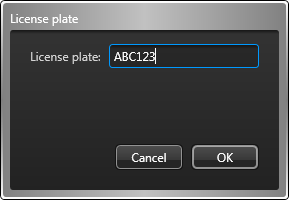
-
Enter the license plate number.
NOTE: You do not need to enter spaces that appear in the license plate number. The system treats "ABC123" and "ABC 123" as the same plate.
- Click OK.
-
Enter the license plate number.
-
In the Entity name field, enter a name
for the credential entity.
The following screen capture is for card credentials. The dialog box looks different if you selected PIN or License plate credentials.
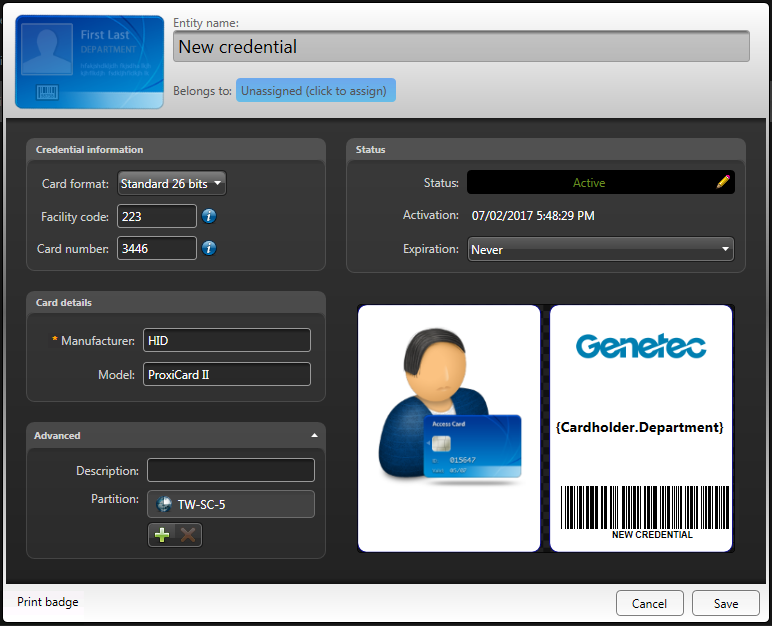
-
Click the Belongs to field, select a cardholder or visitor
to assign the credential to, and then click OK.
Without assigning a credential, you cannot monitor the activities, or generate activity reports for that cardholder or visitor.
-
In the
Status
section, set the status and activation period for the credential.
If the credential is inactive, the cardholder or visitor does not have access to any area.
- Status:
 Set the credential status to Active.
Set the credential status to Active. - Activation:
 Displays the current date.
Displays the current date. - Expiration:
 Set an expiration for the credential:
Set an expiration for the credential:- Never:The credential never expires.
- Specific date:The credential expires on a specific date and time.
- Set expiration on first use:The credential expires after a specified number of days after the first use.
- When not used:The credential expires when it has not been used for a specified number of days.
- If custom fields are defined for credentials, such as the manufacturer, the card model, and so on, enter the credential’s custom information under the designated section.
-
(Optional) Click the
Advanced
section, and configure the following credential properties:
- In the Description field, type a description for the credential.
-
Assign the credential to a partition.
Partitions determine which Security Center users have access to this entity. Only users who have been granted access to the partition can see the credential.
-
(Optional) If the credential is a card credential (not a PIN), select a badge
template.
- In the lower-right corner of the credential details dialog box, click the badge image.
-
Select a badge template, and then click OK.
Badge templates are created in Config Tool.
A print preview of the badge appears, with data corresponding to the credential.
NOTE: The badge template remains associated to the credential even if you unassign the credential from a cardholder or visitor.
- To print the badge, in the lower-left corner of the credential details dialog box, click Print badge.
- When you are finished editing the credential, click Save.
The new credential is added to the list in the Credential management task.
After you finish
To modify a credential, select the credential in the list, and then click Modify (![]() ).
).
